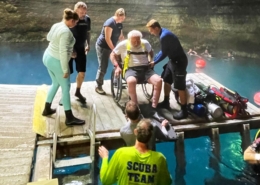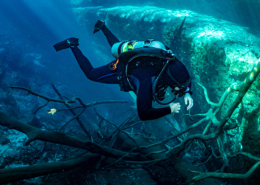Three Easy Steps to Check Your Reg Before a Dive
By Shaun Notley
The excitement of upcoming dive trips is something we all look forward to and enjoy. Common steps in preparation include a gear packing checklist, getting tips from our dive buddies, finalizing travel plans, and visits to our local dive shop for a last-minute accessory. With so much going on, it is easy to forget to spend some time going over your kit before you even start to think about packing.
Here we have three easy steps that will help you decide if your regulators are as ready for your next dive trip as you are.
1. Hands-on Checks
First things first, dig out your regulators from where you store them. If not already, they should be kept away from direct sunlight in a cool, dry place when not in use. Start off with the following hands-on checks:
- Run your hands over each of the hose fittings, everything should be snug. Glance over the whole set up and look for any signs of damage.
- If fitted, pull back the rubber hose protectors. Hoses sometimes have an inspection hole in the metal crimp at each end. If there is an inspection hole, you should be able to see the hose through it. It serves as an indicator that the hose has maintained the correct insertion depth within the fitting.
- Whilst the hose protectors are pulled back, check out the condition of the hoses. Rubber hoses should show no signs of perishing or rubber fatigue. Braided hoses should have no loose or frayed fibers.
- If you can see the first stage filter – easier on yoke models than DIN – check that it looks clean and free from debris.
- Take a good look at mouthpiece condition. Check for holes, splits or wear and that they are firmly secured with a zip tie.
- If your second stages are fitted with diver adjustment knobs or venturi / flow controls, ensure they operate smoothly without getting stuck or feeling gritty. Diver adjustment knobs that control inhalation resistance should be stored wound all the way out.
2. Checks Under Pressure
Checks can be furthered by placing the regulator under pressure for those with their own cylinder at home…
- External leaks can most easily be spotted by submerging the pressurized regulator set in water and observing for bubbles. A common culprit to look out for is a leak between the SPG and high-pressure hose.
- If it is impractical to submerge the whole regulator set, follow these steps: Pressurize the regulator, close the cylinder valve, and observe for several minutes any pressure drop on the SPG. A drop in pressure would indicate an external leak somewhere that needs further checking out.
- A useful gadget familiar to many rebreather divers is an intermediate pressure gauge. Often connecting to a low-pressure inflator hose, it reads the reduced pressure from the first stage. It can be a useful tool for verifying there are no internal leaks within the first stage and it is set to within the correct pressure range.
- The regulator should be free from any external leaks and the intermediate pressure gauge should read a steady pressure. Not all regulators are created equal – the correct intermediate pressure range varies from model to model with cylinder supply pressure even becoming a factor. Often this information is published within the regulator user manual provided at the time of purchase. If you have misplaced your user manual, they are usually downloadable from the manufacturer’s website.
- Breathe from it! Similar as you would in a pre-dive check, make sure the second stages deliver air smoothly and comfortably. Listen out for any unfamiliar noises and anything else that does not feel quite right.
3. Asking Yourself This Question
Time to be honest with yourself. We enjoy owning our own equipment for a variety of reasons – familiarity, comfort, and convenience are some of them. Don’t forget with equipment ownership also comes the responsibility to keep it fit for use.
When was the last time your regulator was serviced or checked out by a professional?
Regular preventive maintenance is one of the best ways to keep your regulators safe and ready for action. Work should always be carried out by a qualified, competent person and completed in line with the manufacturer’s recommendations. If you can’t remember the last service, chances are it is long overdue. Recommended service intervals vary with different manufacturers and may not be solely based on time, but also depend on usage.
None of us want to miss a dive because of faulty equipment or have any doubt in the back of our mind regarding the reliability of what we are breathing from. Before your next trip take a bit of time out of your schedule to check out your gear. Remember, if you have any hesitation or question about the condition of your kit, drop it over to your local dive technician to be given a once over or service.












Leave a Reply
Want to join the discussion?Feel free to contribute!